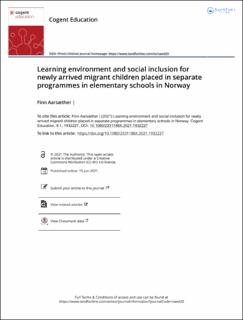| dc.contributor.author | Aarsæther, Finn | |
| dc.coverage.spatial | Norway | en_US |
| dc.date.accessioned | 2021-06-24T14:06:47Z | |
| dc.date.available | 2021-06-24T14:06:47Z | |
| dc.date.created | 2021-06-15T21:55:09Z | |
| dc.date.issued | 2021-06-15 | |
| dc.identifier.citation | Cogent Education. 2021, 8 (1), 1-16). | en_US |
| dc.identifier.issn | 2331-186X | |
| dc.identifier.uri | https://hdl.handle.net/11250/2761201 | |
| dc.description.abstract | Globalmigrationhasledtoincreasingnumbersofchildrenencountering schools as newcomers in their new countries. Statistics reveal that large groups of migrant children tend to perform poorly academically; thus, education for newcomers has become an urgent issue for host countries. The aim of this study is to explore how Norwegian schools facilitate education and social inclusion for newly arrived migrant children, based on qualitative data from separate programmes for newcomers. The findings show a large variation as to how the schools emphasise the teaching of subjects and how they facilitate active learning processes for newcomers. The analyses suggest that this variation, at least partly, is linked to a lack of clarity in the official Norwegian guidelines for the education of newly arrived migrant children. As far as inclusion is concerned, the schools, however, show quite similar results: none of them succeed in creating arenas for interaction between newcomers and mainstream peers. This may have an impact on the newcomers’ well-being, as well as on how fast they learn Norwegian—and hence school subjects—because the verbal and social interac- tion between language learners and target language users is crucial to the develop- ment of L2 skills. | en_US |
| dc.language.iso | eng | en_US |
| dc.publisher | Routledge | en_US |
| dc.relation.ispartofseries | Cogent Education;volume 8, issue 1 | |
| dc.rights | Navngivelse 4.0 Internasjonal | * |
| dc.rights.uri | http://creativecommons.org/licenses/by/4.0/deed.no | * |
| dc.subject | Migrant children | en_US |
| dc.subject | Newcomers | en_US |
| dc.subject | Education | en_US |
| dc.subject | L2-learning | en_US |
| dc.subject | Inclusions | en_US |
| dc.title | Learning environment and social inclusion for newly arrived migrant children placed in separate programmes in elementary schools in Norway. | en_US |
| dc.type | Peer reviewed | en_US |
| dc.type | Journal article | en_US |
| dc.description.version | publishedVersion | en_US |
| dc.rights.holder | © 2021 The Author(s). | en_US |
| dc.source.articlenumber | 1932227 | en_US |
| cristin.ispublished | true | |
| cristin.fulltext | original | |
| cristin.qualitycode | 1 | |
| dc.identifier.doi | https://doi.org/10.1080/2331186X.2021.1932227 | |
| dc.identifier.cristin | 1915995 | |
| dc.source.journal | Cogent Education | en_US |
| dc.source.volume | 8 | en_US |
| dc.source.issue | 1 | en_US |
| dc.source.pagenumber | 16 | en_US |

